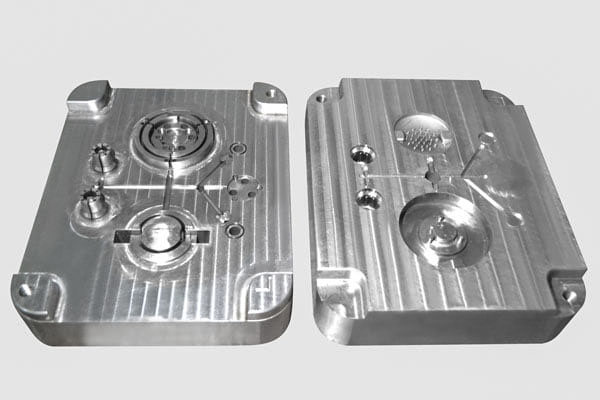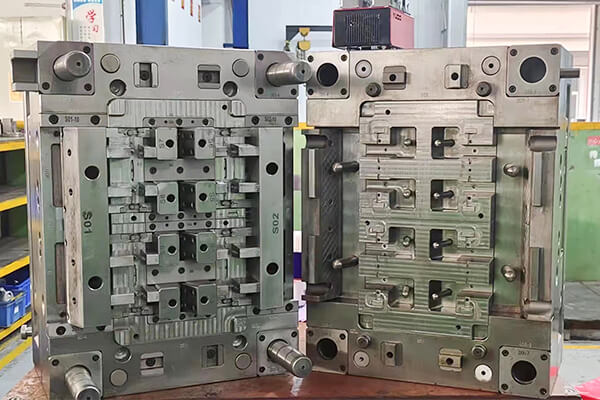Aluminum Injection Molding: Aluminum Tooling for Custom Part
Injection molding is a manufacturing technique used to create both real products and prototypes. Because it makes it possible to produce complex product parts with higher quality and yield, it is dependable and efficient. The design and materials used in higher-quality production have a significant impact on the injection molding process. Therefore, aluminum injection molding is preferred by manufacturers looking for more straightforward mold processes that enable better products at a lower cost.
Durable products are undoubtedly produced by the conventional injection molding process and the steel injection molding process. But since they don’t promise speedy production, they leave a lot to be desired. The benefits and drawbacks of aluminum injection molding, and features of aluminum injection molds will all be covered in this article. Continue reading more about aluminum injection molding.

What is Aluminum Injection Molding?
Aluminum injection molding is a cutting-edge method derived from injection molding, employed for crafting components, be they prototypes or actual products, utilizing aluminum tooling. Aluminum injection molding stands out as a viable substitute for steel injection molding, particularly in the realm of rapid prototyping, and has found extensive application in automotive, aviation, and industrial sectors.
The utilization of aluminum molds is advantageous, primarily facilitating the facile production of intricate items with fewer components. Additionally, aluminum injection molding tool ensures the creation of stable products characterized by uniform structures, high precision, and sleek surfaces. These desirable outcomes are attributed to the aluminum mold’s efficient heat transfer properties, resulting in accelerated product formation.
Aluminum Injection Molding vs Steel Injection Molding
Conventional injection molding relies on steel injection molds for the mass production of parts. However, steel injection molding exhibits certain limitations, necessitating alternative processes like aluminum injection molding.
Differences between aluminum injection molds and steel plastic injection molds extend beyond the materials used (Aluminum and Steel) and encompass their features, designs, and applications.
Flexibility
Steel molds lack flexibility due to their hardness resulting from post-design heat treatment. In contrast, aluminum molds, derived from softer materials, offer greater flexibility. The design permits the creation of mold parts separately, facilitating easier adjustment of prototypes.
Turnaround Time
Aluminum plastic injection molds, crafted through CNC machining or, at times, Electrical Discharge Machining (EDM) for sharp corners, are typically produced in 10-15 days. This efficient timeline is achieved through mechanical methods, without the need for special manufacturing equipment or thermal processing.
Steel injection molds, also originating from a similar process, are costly and require months for production. The hardness of steel necessitates special equipment and thermal processing to enhance mold life.

Mold Robustness
Mold robustness, determined by a mold’s ability to produce parts before corrosion or wear occurs, depends on design and material characteristics.
Steel injection molds, hardened through heat treatment, with few joints, are rigid and durable, capable of producing millions of parts.
Aluminum prototype molds, being crafted from the softer aluminum, exhibit lesser mold robustness than steel molds. However, aluminum alloys offer strength, ensuring a batch production capability of up to 5000 parts.
Production Time
Production time, the duration from polymer injection to final product ejection, is crucial in batch product manufacturing and varies based on mold material, temperature, and pressure.
Aluminum injection molds, not as resilient to high pressure and temperature, result in production times ranging from 40 to 70 seconds. Conversely, steel injection molds, capable of withstanding intense conditions, require only a few seconds for part production.
Features of Aluminum Tooling for Injection Molding
Aluminum stands out as a valuable material in tooling, offering several properties that contribute to the cost-effective creation of low-volume injection molds. Key features make aluminum particularly well-suited for aluminum injection molding and tooling applications in general.
Thermal Expansion and Cooling Rate
Aluminum possesses a notable coefficient of thermal expansion. This characteristic enables rapid cooling after reaching the required temperature, facilitating fast and efficient production. This quality is especially crucial in manufacturing processes that demand swift and effective production, making aluminum an ideal choice for injection molding.
Metallic Properties
Workpiece accuracy hinges on the mechanical strength and rigidity of the tool. Aluminum exhibits robust metallic properties, maintaining a certain level of rigidity and strength. Its ductility further enhances its suitability for use in tooling. Ensuring the tool’s strength during the manufacturing process is vital. In the context of aluminum injection molding, selecting appropriate cutting parameters, grades, and geometries contributes to an efficient molding process. Utilizing aluminum alloys in tooling not only enhances productivity but also lowers the cost-per-component ratio.
Advantages of Aluminum Injection Molding
Cost
The cost of aluminum injection molds is notably lower compared to steel in the manufacturing of injection molds. While the overall worth and return on investment can depend on mold usage, the initial tool investment for aluminum is generally lower when all other factors are equal.
Lead
Aluminum molds ensure a swifter production process. In contrast, steel injection molding can take months from mold design to the realization of the final product. Aluminum injection molds require only days to create molds, prototypes, and the end products.
Good for Low Volumes
For low-volume batch production of parts, aluminum plastic injection molds offer better value. Their reliability in providing lower upfront costs and producing reliable parts in quantities of thousands makes them advantageous.
Machining Time
Aluminum prototype molds excel in dissipating heat faster than steel molds, allowing for quicker heating and cooling. The cooling time during injection molding constitutes a significant portion of the overall molding cycle. Opting for an aluminum injection molding process results in a shorter cycle, translating into faster part production.
Better Products
Non-uniform heating and cooling are major contributors to defects in parts such as sink marks, voids, and burn scars. The exceptional heat dissipation characteristics of aluminum molds enable rapid and uniform heating and cooling, reducing the occurrence of defective parts and rejects.
Easy Repair and Modification
The extreme hardness of steel molds can make repairing or modifying damaged or deformed molds challenging and expensive, often requiring the creation of a new mold. Conversely, aluminum plastic injection molds, derived from softer materials, have a separable and straightforward design. This feature facilitates easy repair and modification in the event of an error in the aluminum injection mold.
Disadvantages of Aluminum Injection Molding
Durability
While aluminum plastic injection molds are suitable for smaller part runs, steel molds outshine them in durability. Steel molds are corrosion-resistant, wear-resistant, and thermally stable, allowing for the production of a larger quantity of products. Despite this, engineers can enhance the durability of aluminum molds through nickel-plating or annealing. However, this modification increases the cost of aluminum injection molds, offsetting the cost advantage associated with aluminum tooling.
Limited Surface Finish
Aluminum plastic injection molds provide limited surface finishes compared to steel molds due to their lower density. The higher density of steel enables various texture selections and custom finishes through the incorporation of steel inserts.
Flash On Part
Flashing, the excess material formed on a mold due to worn-out cavities that no longer fit tightly, is a concern after several thousand production cycles with aluminum plastic injection molds. Wear and non-conformities can lead to flashing in the final product.
Fewer Products
Aluminum injection molding is not well-suited for prolonged exposure to the intense temperature and pressure associated with high-volume injection molding processes. Consequently, it is not ideal for long-term or high-volume part production.
Complexity
In the case of a need for modifications, engineers face limitations with aluminum mold designs as molded parts can impact the mold. In contrast, steel molds can be toughened through heat treatment to handle materials with varying densities, offering greater adaptability to evolving requirements.
Aluminum Injection Molding Design
The design of an aluminum mold is a critical aspect of the product manufacturing process, directly impacting product durability and mold efficiency. Here are key practices that design experts should consider when creating an aluminum mold design.
Make Provision for Possible Revisions
Include a procedure for potential revisions in the initial aluminum mold design. While this may increase the cost initially, it proves cost-effective when corrections are necessary later on. Making provisions for revisions at the outset prevents the need to sacrifice the entire tool for modifications.
Ensure Uniform Wall Thickness
Maintain uniform wall thickness in the aluminum mold design. Thinner sections tend to cool and solidify faster, while denser areas act as reservoirs feeding lighter sections. Feed paths should consider solidification in both thick and thin sections, ensuring consistent plastic part thickness. This approach simplifies the aluminum injection molding process and facilitates rapid progressive solidification.
Use Suitable Alloys
Utilize silicon as a suitable alloy in designing aluminum plastic injection molds due to its high specific heat capacity, aiding in better heat retention than aluminum alone. However, other alloys with a short freezing range can also be effective in promoting solid mechanical properties in the final products.
Take Note of Part Details
In lieu of sharp corners, use fillets when designing aluminum plastic injection molds. Sharp corners can lead to differential shrinkage in the produced part, potentially causing cracking or permanent deformities.
Use Inserts
Incorporate inserts of various shapes and materials, such as brass thread inserts, into the aluminum mold design. This enhances mold durability and provides extra-hard surfaces where needed, contributing to improved overall performance.
Aluminum Injection Molding Service
When an aluminum mold for plastic injection molding fails, it’s usually because of a bad design, bad tooling techniques, and a bad choice of aluminum alloy. Thus, aluminum injection molding, its properties, and some design advice were presented in this article.
Prototype mold for aluminum can be intimidating. With its in-depth understanding of the procedure and proven track record in managing product development, Sungplastic can ensure superior product creation for you.
We offer aluminum injection mold design that is optimized for product manufacturing. Seek guidance from our support staff regarding manufacturing. To receive a quote for your design right away, get in touch with us and send us your file if you already have one.
FAQs
How Long Does an Aluminum Injection Mold Last?
The lifespan of an aluminum injection mold is contingent upon its utilization in product manufacturing. When employed for prototyping, aluminum injection molds can yield a few thousand parts, influenced by the density of the molds. However, the lifespan diminishes when used for intensive product manufacturing. Recent advancements, such as the incorporation of surface coating and anodizing, have been implemented to enhance the durability of aluminum molds, extending their usefulness in production cycles.
Is Aluminum Injection Molding a Better Option Compared to Steel Injection Molding?
The preference between aluminum and steel injection molding hinges significantly on the specifics of your design and the desired products. Both injection processes serve as complementary alternatives, each offering distinct advantages and disadvantages. Engineers must carefully weigh these factors before deciding on a manufacturing process for optimal results.
Get a free quote and design analysis today.
We’ll reply to you within 6 working hours.
We respect your privacy.
+86 139 2927 4777 (WhatsApp, Wechat)
